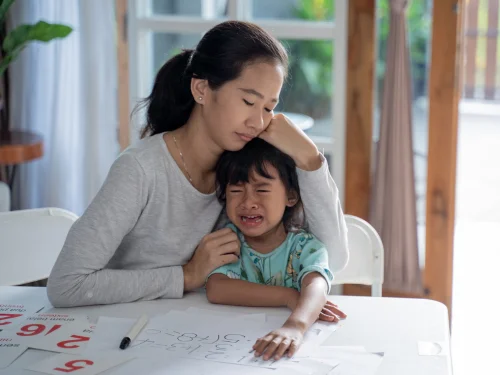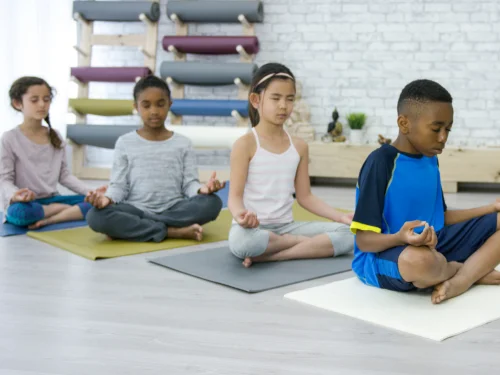6 Coping Skills for Kids: Helping Children Navigate Big Feelings

Yes—finger plays, clapping games, and dance routines that use hand gestures all help. Combine rhythm and repetition for deeper learning.
Send home simple activity ideas, kits, or worksheets. Offer short instructions and encourage family involvement. Regular practice builds lasting progress.
Try origami, sticker scenes, stringing pasta, or painting with Q-tips. Crafts that use small pieces build precision and control.
Children face all sorts of stressors in today’s world—academic pressure, family changes, peer conflicts, overwhelming emotions, and more. While stress is a normal part of life, kids often lack the tools or words to deal with it in healthy ways. That’s where coping skills come in. Teaching kids how to recognize and manage their feelings is a gift that supports their lifelong well-being.
What Are Coping Skills?

Coping skills are tools and strategies people use to deal with stress, big emotions, or difficult situations. For children, these skills help them manage their emotional reactions in ways that are safe and constructive. Whether it’s a calming breath or a creative activity, coping tools give kids the power to self-regulate and bounce back from challenges.
Why Coping Skills Matter for Kids
.webp)
Learning to cope doesn't just help kids in the moment—it shapes how they view themselves and the world. Kids who practice positive coping strategies are more likely to:
- Develop emotional awareness and self-control
- Form stronger relationships
- Perform better in school
- Reduce behavioral issues
- Build confidence and resilience
Without guidance, some children may turn to unhealthy coping mechanisms such as aggression, avoidance, or negative self-talk. That’s why early intervention and consistent modeling from adults are key.
Healthy Coping Strategies for Children
.webp)
Coping skills can be grouped into several helpful categories. Each serves a unique purpose in helping a child feel more in control and connected.
1. Self-Soothing
These strategies calm the body and mind:
- Deep breathing or belly breaths
- Holding a favorite stuffed animal or blanket
- Listening to calming music
- Taking a warm bath
- Guided imagery (imagining a favorite peaceful place)
2. Distraction
Shifting attention can reduce emotional intensity:
- Playing a game or puzzle
- Drawing or coloring
- Reading a book
- Watching a favorite show
- Playing outside
3. Opposite Action
These involve doing something that creates the opposite feeling of distress:
- Dancing to upbeat music
- Laughing at a funny video
- Doing a kind act for someone
- Participating in sports or movement
4. Emotional Awareness
Helping children name and understand their emotions builds self-regulation:
- Talking to a trusted adult
- Journaling feelings with words or drawings
- Using coping statements like “This will pass” or “I can handle this”
- Reading books about emotions
5. Mindfulness
Staying present helps ground kids when emotions run high:
- Breathing exercises with counting
- The “5-4-3-2-1” sensory grounding technique
- Mindful movement (yoga, stretching)
- Noticing nature during a walk
6. Gratitude
Gratitude builds emotional strength and shifts focus toward the positive:
- Sharing three good things that happened today
- Writing a thank-you note
- Saying “thank you” to someone every day
- Creating a gratitude jar
The ABCs of Coping: A Simple Tool for Young Kids
.webp)
Teaching coping skills can be playful and memorable. One approach is using the ABCs of Coping, where each letter represents a different calming activity or idea. For example:
- A – Ask for help
- B – Belly breaths
- C – Count to ten
- D – Draw or color
- H – Hug someone or something
- L – Listen to music
- Q – Quiet time alone
- W – Water sips
- Z – Zero in on a calming task
This playful format turns learning into a game and makes it easier for children to recall skills when needed.
How Parents and Caregivers Can Help
Children learn how to cope by watching the adults around them. Caregivers can support this process by:
- Modeling healthy coping in their own lives
- Talking openly about feelings
- Making coping part of daily routines
- Creating a family coping toolbox with go-to activities
- Using storybooks or movies to point out how characters manage emotions
Tips for Supporting Teens
.webp)
Teenagers may not relate to the term “coping skills,” but they still need tools for stress. Try asking what makes them feel better after a bad day and validate those strategies. Encourage them to explore what helps—whether that’s listening to music, playing sports, hanging with friends, or journaling. Framing it as a “stress reset” or “calm plan” may be more effective than formal labels.
You May Also Like: What Is Sensory Overload? Understanding, Recognizing, and Managing Overstimulation
When to Seek Additional Help
.webp)
If your child’s stress is affecting their daily life—such as sleeping, eating, or school performance—it might be time to seek professional support. Pediatric mental health professionals can help assess challenges and teach both the child and family how to build personalized coping plans.
You May Also Like: 15 Mindfulness Activities for Kids: Simple Ways to Build Calm, Focus, and Emotional Strength
Final Thoughts
.webp)
Every child is different, and so is the way they cope. Building coping skills isn’t about finding one-size-fits-all solutions—it’s about giving kids a toolbox they can reach into whenever they face something hard. With patience, practice, and plenty of support, children can learn to navigate life’s ups and downs with confidence and calm.
You May Also Like: 15 Impulse Control Activities for Kids: Fun Ways to Build Self-Regulation




